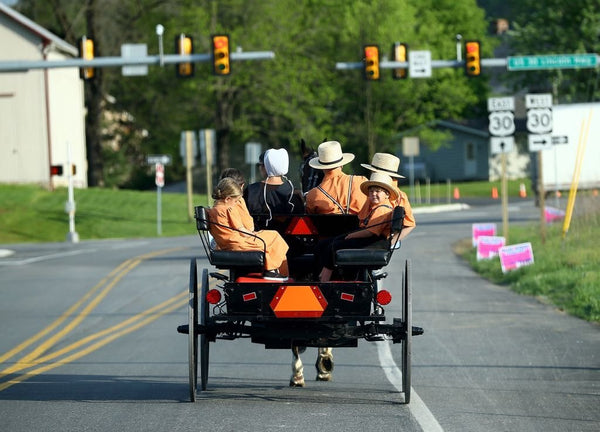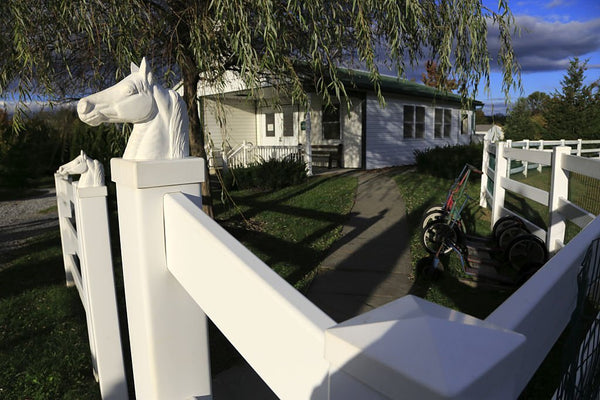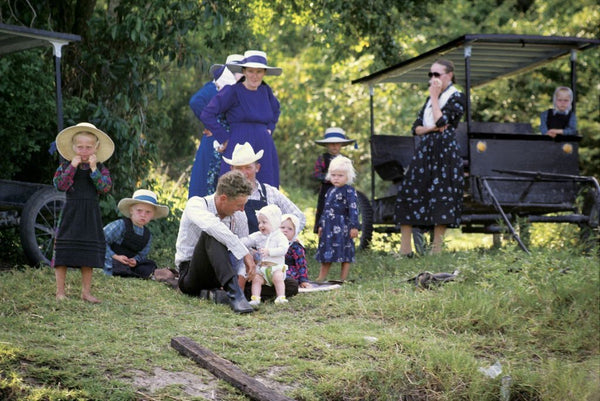The word Amish usually prompts images of plain dress, local communities, and intensely family-oriented life, but the average American is still in the dark about the Amish way of life.
Generally speaking, Amish values emphasize the importance of simple living, rural life, and Gelassenheit (submission to God’s will). They place a lot of value upon manual labor and craftsmanship, humility, and maintaining self-sufficiency.
Numerous subgroups of Amish have been established over many years. Typically, a new subgroup is created when there are disagreements over particular topics, practices, or rules.
Let’s delve into what makes up the different types of Amish communities.
What this article covers:
- Different Types of Amish
- Levels of Amish
- How Many Types of Amish Are There? (FAQs)
- What Do You Call a Group of Amish? (FAQs)
- What Is the Strictest Amish Group? (FAQS)
Different Types of Amish

Before we can fully explore the different types of Amish people, we have to discuss the basics of Amish society.
Amish people have Swiss/German or Alsation origins and live in North America today. So, technically, the Amish are German, but they’ve been in North America for centuries and can certainly be viewed as established members of North American culture.
Most Amish groups and subgroups share similar traits, like traditional Amish cuisine, so it can be difficult for an outsider to distinguish between the different types of Amish.
Let’s have a look at some of the different communities, and uncover which Amish norms are common across the board and which ones led to the formation of these different sects.
Old Order Amish
The Old Order Amish is the group that usually comes to mind when most people hear the word Amish.
Let’s delve a little into the history of the Amish.
In 1878, they separated from progressives called “Amish Mennonites”. Since then, they have distinguished themselves from other less conservative groups. They’ve achieved this through strict practice of forbidding automobile ownership and strictly adhering to traditional style of dress.
It’s this strict insistence on following rules to a tee that has led many to wonder whether the Old Order is an Amish cult, but members are free to leave. Whether they’ll be allowed back or not is more complex and, depending on the strength of their convictions and repentance, it may result in shunning.

Shunning the most recognized of the Amish punishments, and it occurs when a member wilfully violates Ordnung and is done out of concern for the well-being of the individual as well as to protect the flock.
Over 350,000 Old Order Amish people live in the US, and approximately 6,000 are in Canada. They’re one of the fastest-growing populations in the world. This may be because they don’t typically use birth control.
Like most Amish groups, they wear plain clothing, travel by horse and carriage, and practice nonresistance (also known as Christian pacifism), meaning they don’t participate in military service.
A key belief held by the Old Order Amish is that a person can only hope to be saved. It’s considered a form of pride to claim assurance of salvation.
Interestingly, Old Order Amish don’t build churches. Instead, they hold worship services in private homes. For this reason, they are sometimes referred to as House Amish.
There are numerous subgroups of Old Order Amish, including Nebraska Amish, Swartzentruber Amish, Buchanan Amish, Swiss Amish, and Lancaster Amish.
New Order Amish
In 1966, under the threat of excommunication, the New Order Amish began their split from the Old Order Amish, mainly because of their desire to change standard practice regarding the use of modern farming technology, and to relax youth courting standards.

While they still prohibit the use of the internet, television, and radio, they are seen as more progressive than Old Order Amish in terms of their use of modern technology.
New Order Amish do allow some electricity, and some even allow telephones at home.
Moreover, they wanted to incorporate more Evangelical practices, such as Sunday School and missionary work into their lifestyles. As a result of this expansive thinking, they’re far more lenient when it comes to the practice of shunning.
Like the Old Order, they travel by buggy, wear plain clothing, worship in private homes, and Pennsylvania Dutch is their preferred Amish language.
However, in contrast to the Old Order, they do not practice bundling. This was a key factor in the original division of the two groups.
The New Order is also recognized for introducing brighter-colored clothing into daily life, which the Old Order discourages in an attempt to stave off the dangers of vanity.
Beachy Amish Mennonite
The Beachy Amish Mennonites differ considerably from other types of Amish groups.
To an outsider, they lack several typical Amish features, such as the use of horse and carriage, not worshiping in private homes, and not speaking in German.
Moreover, unlike Old Order Amish, Beachy Amish Mennonites have meeting houses, Sunday Schools, as well as Bible Schools for young adults. Like New Order Amish, they support missionary work.

Yet, they also distinguished themselves from New Order Amish by not practicing social shunning and permitting the ownership of automobiles and the use of filtered internet.
Consequently, they are often grouped with the Amish Mennonites (more info below), as they’re remarkably similar.
Nevertheless, they do have numerous similarities to Old Order Amish. Women wear head coverings and bonnets, married men have beards, and radio and television are forbidden.
Mennonites
The Amish Mennonites, mentioned above, were established through a series of reform movements between 1862-1878. They are now considered Mennonites of Amish descent, but Mennonite groups of Amish origin have removed “Amish” from the titles of their congregations over the years to reflect the departure from Old Order traditions.
Today, like the Amish, Mennonites place heavy emphasis on voluntary faith and overcoming injustice through the power of doing good, but there is a lot more freedom in the way Mennonite men may choose to dress or style their beards. Mennonites are also allowed to drive motorized cars and regularly use electricity and telephones in their homes.
Levels of Amish
Generally speaking, Amish life is governed by Ordnung, meaning order.
Outsiders can easily identify similarities between the groups, but may struggle to pick out certain nuances to help differentiate.
There are important distinctions to be made across the different types of Amish subgroups. Noticeably, they vary in their levels of conservatism and progression.
What’s more, even amongst the types of Amish that agree upon a particular practice, there are differences in how they do it.
Differences in Practices

- While most Amish groups use horse and carriage transport, the lights on the carriage range from bright, battery-operated lights to a single lantern.
- The colors of clothing vary considerably, ranging from dark to bright colors between different groups of Amish.
- The length of men’s beards also differs between groups, as well as women’s prayer coverings and hats.
Contrary to popular belief, most Amish willingly interact with the outside world, but the amount of interaction they choose to have differs according to the different sects.
Because farm life is a key aspect of Amish life, they often can be found in farmers’ markets selling their produce.
Conclusion
While it’s tempting for outsiders to lump all Amish together under one isolated, passionate umbrella, it’s important to remember that, as in most communities and cultures, there are nuances and factions that make up the overall Amish community.
That being said, while they may not agree on certain rules or have absolute consensus over the limits they impose upon themselves, the Amish all agree on the importance of living as God intended, surrounded by family and peaceful harmony.
Amish Baskets is committed to sharing the craftsmanship and mastery of these communities with a much broader, enthusiastic audience. Much of the Amish way of life is idyllic, and their emphasis on maintaining peace is something that should resonate with far more people. You can emulate the tranquility of the Amish household with their exquisite sewing baskets, foster the imagination of your children with authentic Amish dolls, or even beautify your home with hand-crafted bathroom baskets or hanging mail organizers.
How Many Types of Amish Are There? (FAQs)
It’s very difficult to pinpoint exactly how many types of Amish groups exist today. In 2015, the authors of the book “The Amish” reported over 40 different Amish affiliations.
This measurement is based on Amish being present in at least 2 districts, with at least 20 years of shared history.
What Do You Call a Group of Amish? (FAQs)
There isn’t a specific name for a group of Amish, other than perhaps a ‘community’. It is common to refer to them by the name of their group or subgroup.
What Is the Strictest Amish Group? (FAQS)
Some consider the Swartzentruber Amish to be the strictest Amish group due to their restrictive technology use. Riding in cars is permitted only in emergencies and is otherwise prohibited.
Additionally, their dress tends to be heavier and plainer, and their church services tend to be longer in comparison to other groups.
Did You Find Our Blog Helpful? Then Consider Checking:
